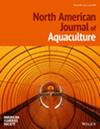利用消化生理学制定黑带太阳鱼(一种原产于美国的濒危中心鱼类)的幼虫培养方案
IF 1.3
4区 农林科学
Q3 FISHERIES
引用次数: 0
摘要
黑带太阳鱼(Blackbanded Sunfish Enneacanthus chaetodon)是美国新泽西州到佛罗里达州中部水流缓慢的水域中特有的一种小型中心鱼类。主要由于栖息地退化,该物种的分布日益破碎。制定幼体培养规程对于生产该物种用于水族馆贸易和潜在的恢复工作至关重要。为了简化生产过程,应在不影响幼体生长或存活的情况下,尽早将幼体从活体饲料过渡到惰性饲料。本文章由计算机程序翻译,如有差异,请以英文原文为准。
Using digestive physiology to develop larval culture protocols for the Blackbanded Sunfish, a threatened centrarchid native to the United States
The Blackbanded Sunfish Enneacanthus chaetodon is a small centrarchid that is endemic to slow-moving waters from New Jersey to central Florida, United States. The distribution of this species has been increasingly fragmented, primarily due to habitat degradation. The development of larval culture protocols is essential to produce this species for the aquarium trade and for potential restoration efforts. To streamline the production process, larvae should be transitioned from live feeds to inert diets as early as possible without sacrificing larval growth or survival.
求助全文
通过发布文献求助,成功后即可免费获取论文全文。
去求助
来源期刊
CiteScore
2.50
自引率
0.00%
发文量
46
审稿时长
18-36 weeks
期刊介绍:
The North American Journal of Aquaculture publishes papers on new research and practical experience in all areas of intensive and extensive fish culture. Topics include broodstock selection and spawning, nutrition and feeding, health and water quality, facilities and production technology, and the management of ponds, pens, and raceways.
The journal will consider papers dealing with ways to improve the husbandry of any aquatic species—marine or freshwater, vertebrate or invertebrate—raised for commercial, scientific, recreational, enhancement, or restoration purposes that may be of interest to practitioners in North America. Its scope includes both basic and applied science, but applied scientific endeavors—including practical experiences, descriptive studies, and other nontraditional, but pertinent works—are emphasized.

 求助内容:
求助内容: 应助结果提醒方式:
应助结果提醒方式:


